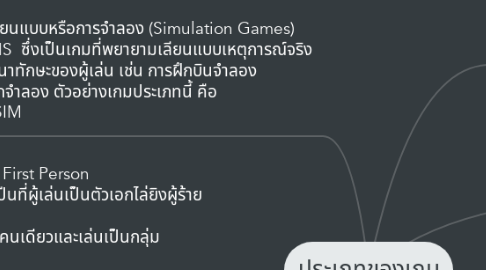
1. 4.เกม RPG (Role-Playing) เป็นเกมที่ผู้เล่นสามารถสร้างหรือเลือก character ของตัวละครให้ตรงกับความชอบของตัวเอง แล้วเล่นไปตามเนื้อเรื่องของเกม ตัวอย่างเกมประเภทนี้ ได้แก่ Racknaroc,Diablo II
2. 3.เกมผจญภัย (Adventure Games) มีวัตถุประสงค์ของเกมเพื่อทำภารกิจให้สำเร็จในดินแดนที่สร้างขึ้น ต้องแก้ไขปัญหาหรือหาสิ่งจำเป็นในระดับของเกมที่แตกต่างกันไป เช่น หากุญแจเพื่อไขเปิดห้องลับเพื่อไปหยิบอาวุธ เกมประเภทนี้ได้แก่ Myst ,Zelda
3. 2.เกมแอคชั่นแบบ FPS(Action First Person Shooters Games) เป็นเกมยิงปืนที่ผู้เล่นเป็นตัวเอกไล่ยิงผู้ร้าย ไปจนถึงสัตว์ประหลาดต่างๆ ตามระดับการเล่น มีทั้งเล่นแบบคนเดียวและเล่นเป็นกลุ่ม ตัวอย่างเกมประเภทนี้ได้แก่ Doom,Half-Life,Quake III
4. 1.เกมเลียนแบบหรือการจำลอง (Simulation Games) เช่น SIMS ซึ่งเป็นเกมที่พยายามเลียนแบบเหตุการณ์จริง เพื่อพัฒนาทักษะของผู้เล่น เช่น การฝึกบินจำลอง การขับรถจำลอง ตัวอย่างเกมประเภทนี้ คือ Flight SIM
5. 8.เกมกีฬาและการแข่งขัน (Sport & Racing Games) วัตถุประสงค์ของเกมเพื่อการเป็นที่หนึ่งของการแข่งขัน เช่น แข่ งรถ แข่งฟุตบอล เช่น FIFA Soccer
5.1. Customer and Market Analysis
5.2. Service Offer Definition
5.3. Revenue Forecast and Financial Analysis
5.4. Sales Execution Plan
5.5. Go-To-Market Strategy
6. 7.เกมปริศนา (Puzzle Game) เกมแก้ปัญหาให้ลุล่วงตามจุดประสงค์หลักของเกม เช่น Tetris(เกมตัวต่อ นั่นเอง)
6.1. Market Analysis
6.1.1. Situational Analysis / Drivers
6.1.1.1. What is driving us to do this?
6.1.1.2. SWOT Analysis
6.1.1.2.1. Strengths
6.1.1.2.2. Weaknesses
6.1.1.2.3. Opportunities
6.1.1.2.4. Threats
6.1.1.3. Customer Findings - What have we learned from customers?
6.1.2. Competitive Analysis
6.1.2.1. Do we have competitors and threats in these target markets with the proposed offerings?
6.1.2.2. What are our competitors doing and how are they positioning?
6.1.2.3. How do we position against each competitor?
6.1.3. Target Customer(s)
6.1.3.1. Buyer Profile
6.1.3.1.1. Title
6.1.3.1.2. Industry
6.1.3.1.3. Geography
6.1.3.1.4. Business Size
6.1.3.2. Influencer Profile
6.1.3.3. User Profile
6.1.3.4. What do customers want and need?
6.1.3.5. What business problems do each of these customers have?
6.1.4. Customer Segmentation
6.1.4.1. Which customers or sets of customers do we sell to?
6.1.4.2. What are the target market segments that we want to go after?
6.1.4.3. What are the distinct problems for each segment of the market?
6.1.5. Total Available Market
6.1.5.1. New Prospects
6.1.5.1.1. How much of each target segment have we penetrated?
6.1.5.1.2. How much opportunity is available in each target segment?
6.1.5.2. Existing Customers
6.1.5.2.1. Can we up-sell existing customers?
6.2. Offer Definition
6.2.1. Service Offer
6.2.1.1. What are we selling?
6.2.1.2. Product Definition
6.2.1.3. Pricing
6.2.1.4. Packaging
6.2.1.5. Positioning
6.2.2. Value Proposition
6.2.2.1. What is the Value Proposition to the Customer?
6.2.2.2. What pain are we solving?
6.3. Financial Analysis
6.3.1. Revenue Forecasts
6.3.1.1. Revenue and P&L Forecast (5 Years)
6.3.1.2. Revenue should be split out quarterly
6.3.2. Cost Analysis
6.3.2.1. Should include a description of the costs in entering this business and profitability analysis
6.3.3. Profitability Analysis
6.3.3.1. P&L for the offer to include gross margin, net income and break even analysis.
6.4. Sales Execution Plan
6.4.1. Sales Strategy
6.4.1.1. Direct Sales Strategy
6.4.1.2. Inside Sales Strategy
6.4.1.3. Channel Sales Strategy
6.4.2. Partner Strategy
6.4.2.1. Channel Strategy
6.4.2.1.1. What 3rd party channels should we consider for reselling this service?
6.4.2.2. Technology Partnerships
6.4.2.2.1. What technology vendors (if any) do we need to work with to execute on this plan?
6.4.2.3. Solutions Partners
6.5. Go-To-Market Strategy
6.5.1. Positioning & Messaging
6.5.1.1. What is the key messaging and positioning for the service offer? (Pain, alternatives, solution)
6.5.1.2. How do we communicate internally?
6.5.1.3. How do we communicate externally?
6.5.2. Promotion Strategy
6.5.2.1. Marketing Programs (Installed base versus new prospects)
6.5.2.2. Advertising (Publications, etc.)
6.5.2.3. Analyst Relations (Target Analysts)
6.5.2.4. Public Relations
6.5.2.5. Events (Trade shows, SEO/SEA, Seminars)
6.5.2.6. Webinars
6.5.3. Demand Generation & Lead Qualification
6.5.3.1. How do we generate and qualify new leads for the target offer?
6.5.3.2. Prospect Lists
6.5.3.3. Key Questions to Ask
6.5.3.4. Sales Collateral
6.5.3.5. Presentations
6.5.3.6. Data Sheets
6.5.3.7. White Papers
6.5.3.8. ROI Tools
6.5.3.9. Other Sales Tools (web site, etc.)
6.6. Measure and Improve
6.6.1. Numbers, budget, waterfall, break-even (cost>leads>trials>deals)
6.6.2. Sales Programs
6.6.3. Accelerated Learning Strategy, Controls, Metrics
6.6.4. Include feedback loops
6.6.5. Include financial metrics (definition of success)
6.6.6. Pipeline reports, etc…
6.7. Other Considerations
6.7.1. M&A?
6.7.2. Risk Analysis & Mitigation
7. 5.เกมต่อสู้ (Fighting Game) เป็นเกมต่อสู้กันโดยมีตัวละครต่อสู้กันแบบตัวต่อตัว ด้วยเทคนิคการต่อสู้เฉพาะตัว ตัวอย่างเกมประเภทนี้ ได้แก่ Mortal Kombat,Boxing
7.1. Purpose
7.1.1. This document describes our Go To Market Plan for <Product Name>.
7.2. Stakeholders
7.3. Project Team
7.4. Related Documents
7.5. Author(s)
7.6. Sign-Off List
7.6.1. Training
7.6.2. Channels
7.6.3. International
7.6.4. Public Sector
7.6.5. Sales
7.6.6. Marketing Communications
7.6.7. Product Management

